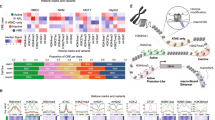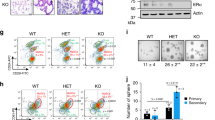Abstract
The tumor suppressor gene hypermethylated in cancer 1 (HIC1), which encodes a transcriptional repressor, is epigenetically inactivated in various human cancers. In this study, we show that HIC1 is a direct transcriptional repressor of the gene encoding ephrin-A1, a cell surface ligand implicated in the pathogenesis of epithelial cancers. We also show that mouse embryos lacking both Hic1 alleles manifest developmental defects spatially associated with the misexpression of ephrin-A1, and that overexpression of ephrin-A1 is a feature of tumors arising in Hic1 heterozygous mice in which the remaining wild-type allele is epigenetically silenced. In breast cancer, we find that ephrin-A1 expression is common in vivo, but that in cell culture, expression of the EphA receptors is predominant. Restoration of HIC1 function in breast cancer cells leads to a reduction in tumor growth in vivo, an effect that can be partially rescued by co-overexpression of ephrin-A1. Interestingly, overexpression of ephrin-A1 in vitro triggers downregulation of EphA2 and EphA4 levels, resulting in an expression pattern similar to that seen in vivo. We conclude that Hic1 spatially restricts ephrin-A1 expression in development, and that upregulated expression of ephrin-A1 resulting from epigenetic silencing of HIC1 in cancer cells may be an important mechanism in epithelial malignancy.
This is a preview of subscription content, access via your institution
Access options
Subscribe to this journal
Receive 50 print issues and online access
$259.00 per year
only $5.18 per issue
Buy this article
- Purchase on Springer Link
- Instant access to full article PDF
Prices may be subject to local taxes which are calculated during checkout






Similar content being viewed by others
References
Arvanitis D, Davy A . (2008). Eph/ephrin signaling: networks. Genes Dev 22: 416–429.
Brantley-Sieders DM, Caughron J, Hicks D, Pozzi A, Ruiz JC, Chen J . (2004). EphA2 receptor tyrosine kinase regulates endothelial cell migration and vascular assembly through phosphoinositide 3-kinase-mediated Rac1 GTPase activation. J Cell Sci 117: 2037–2049.
Brantley-Sieders DM, Fang WB, Hwang Y, Hicks D, Chen J . (2006). Ephrin-A1 facilitates mammary tumor metastasis through an angiogenesis-dependent mechanism mediated by EphA receptor and vascular endothelial growth factor in mice. Cancer Res 66: 10315–10324.
Briggs KJ, Corcoran-Schwartz IM, Zhang W, Harcke T, Devereux WL, Baylin SB et al. (2008). Cooperation between the Hic1 and Ptch1 tumor suppressors in medulloblastoma. Genes Dev 22: 770–785.
Carter MG, Johns MA, Zeng X, Zhou L, Zink MC, Mankowski JL et al. (2000). Mice deficient in the candidate tumor suppressor gene Hic1 exhibit developmental defects of structures affected in the Miller-Dieker syndrome. Hum Mol Genet 9: 413–419.
Chen W, Cooper TK, Zahnow CA, Overholtzer M, Zhao Z, Ladanyi M et al. (2004). Epigenetic and genetic loss of Hic1 function accentuates the role of p53 in tumorigenesis. Cancer Cell 6: 387–398.
Chen WY, Wang DH, Yen RC, Luo J, Gu W, Baylin SB . (2005). Tumor suppressor HIC1 directly regulates SIRT1 to modulate p53-dependent DNA-damage responses. Cell 123: 437–448.
Chen WY, Zeng X, Carter MG, Morrell CN, Chiu Yen RW, Esteller M et al. (2003). Heterozygous disruption of Hic1 predisposes mice to a gender-dependent spectrum of malignant tumors. Nat Genet 33: 197–202.
Chong SS, Pack SD, Roschke AV, Tanigami A, Carrozzo R, Smith AC et al. (1997). A revision of the lissencephaly and Miller-Dieker syndrome critical regions in chromosome 17p13.3. Hum Mol Genet 6: 147–155.
Deltour S, Guerardel C, Leprince D . (1999). Recruitment of SMRT/N-CoR-mSin3A-HDAC-repressing complexes is not a general mechanism for BTB/POZ transcriptional repressors: the case of HIC-1 and gammaFBP-B. Proc Natl Acad Sci USA 96: 14831–14836.
Deltour S, Guerardel C, Stehelin D, Leprince D . (1998). The carboxy-terminal end of the candidate tumor suppressor gene HIC-1 is phylogenetically conserved. Biochim Biophys Acta 1443: 230–232.
Deltour S, Pinte S, Guerardel C, Wasylyk B, Leprince D . (2002). The human candidate tumor suppressor gene HIC1 recruits CtBP through a degenerate GLDLSKK motif. Mol Cell Biol 22: 4890–4901.
Easty DJ, Hill SP, Hsu MY, Fallowfield ME, Florenes VA, Herlyn M et al. (1999). Up-regulation of ephrin-A1 during melanoma progression. Int J Cancer 84: 494–501.
Esteller M . (2008). Epigenetics in cancer. N Engl J Med 358: 1148–1159.
Fujii H, Biel MA, Zhou W, Weitzman SA, Baylin SB, Gabrielson E . (1998). Methylation of the HIC-1 candidate tumor suppressor gene in human breast cancer. Oncogene 16: 2159–2164.
Guo H, Miao H, Gerber L, Singh J, Denning MF, Gilliam AC et al. (2006). Disruption of EphA2 receptor tyrosine kinase leads to increased susceptibility to carcinogenesis in mouse skin. Cancer Res 66: 7050–7058.
Hanahan D, Weinberg RA . (2000). The hallmarks of cancer. Cell 100: 57–70.
He TC, Zhou S, da Costa LT, Yu J, Kinzler KW, Vogelstein B . (1998). A simplified system for generating recombinant adenoviruses. Proc Natl Acad Sci USA 95: 2509–2514.
Herath NI, Spanevello MD, Sabesan S, Newton T, Cummings M, Duffy S et al. (2006). Over-expression of Eph and ephrin genes in advanced ovarian cancer: ephrin gene expression correlates with shortened survival. BMC Cancer 6: 144.
Hirotsune S, Pack SD, Chong SS, Robbins CM, Pavan WJ, Ledbetter DH et al. (1997). Genomic organization of the murine Miller-Dieker/lissencephaly region: conservation of linkage with the human region. Genome Res 7: 625–634.
Holder N, Klein R . (1999). Eph receptors and ephrins: effectors of morphogenesis. Development 126: 2033–2044.
Iida H, Honda M, Kawai HF, Yamashita T, Shirota Y, Wang BC et al. (2005). Ephrin-A1 expression contributes to the malignant cha. Gut 54: 843–851.
Jenal M, Trinh E, Britschgi C, Britschgi A, Roh V, Vorburger SA et al. (2009). The tumor suppressor gene hypermethylated in cancer 1 is transcriptionally regulated by E2F1. Mol Cancer Res 7: 916–922.
Jones PA, Baylin SB . (2007). The epigenomics of cancer. Cell 128: 683–692.
Kinzler KW, Vogelstein B . (1996). Lessons from hereditary colorectal cancer. Cell 87: 159–170.
Kullander K, Klein R . (2002). Mechanisms and functions of Eph and ephrin signalling. Nat Rev Mol Cell Biol 3: 475–486.
Macrae M, Neve RM, Rodriguez-Viciana P, Haqq C, Yeh J, Chen C et al. (2005). A conditional feedback loop regulates Ras activity through EphA2. Cancer Cell 8: 111–118.
Miao H, Li DQ, Mukherjee A, Guo H, Petty A, Cutter J et al. (2009). EphA2 mediates ligand-dependent inhibition and ligand-independent promotion of cell migration and invasion via a reciprocal regulatory loop with Akt. Cancer Cell 16: 9–20.
Miao H, Wei BR, Peehl DM, Li Q, Alexandrou T, Schelling JR et al. (2001). Activation of EphA receptor tyrosine kinase inhibits the Ras/MAPK pathway. Nat Cell Biol 3: 527–530.
Nakamura R, Kataoka H, Sato N, Kanamori M, Ihara M, Igarashi H et al. (2005). EPHA2/EFNA1 expression in human gastric cancer. Cancer Sci 96: 42–47.
Ogawa K, Pasqualini R, Lindberg RA, Kain R, Freeman AL, Pasquale EB . (2000). The ephrin-A1 ligand and its receptor, EphA2, are expressed during tumor neovascularization. Oncogene 19: 6043–6052.
Pasquale EB . (2005). Eph receptor signalling casts a wide net on cell behaviour. Nat Rev Mol Cell Biol 6: 462–475.
Pasquale EB . (2008). Eph-ephrin bidirectional signaling in physiology and disease. Cell 133: 38–52.
Poliakov A, Cotrina M, Wilkinson DG . (2004). Diverse roles of eph receptors and ephrins in the regulation of cell migration and tissue assembly. Dev Cell 7: 465–480.
Potla L, Boghaert ER, Armellino D, Frost P, Damle NK . (2002). Reduced expression of EphrinA1 (EFNA1) inhibits three-dimensional growth of HT29 colon carcinoma cells. Cancer Lett 175: 187–195.
Shi L, Itoh F, Itoh S, Takahashi S, Yamamoto M, Kato M . (2008). Ephrin-A1 promotes the malignant progression of intestinal tumors in Apc(min/+) mice. Oncogene 27: 3265–3273.
Takai N, Miyazaki T, Fujisawa K, Nasu K, Miyakawa I . (2001). Expression of receptor tyrosine kinase EphB4 and its ligand ephrin-B2 is associated with malignant potential in endometrial cancer. Oncol Rep 8: 567–573.
Tang XX, Evans AE, Zhao H, Cnaan A, London W, Cohn SL et al. (1999). High-level expression of EPHB6, EFNB2, and EFNB3 is associated with low tumor stage and high TrkA expression in human neuroblastomas. Clin Cancer Res 5: 1491–1496.
van Rechem C, Rood BR, Touka M, Pinte S, Jenal M, Guerardel C et al. (2009). The scavenger chemokine (C-X-C motif)receptor7 CXCR7 is a direct target gene of hypermethylated in cancer 1 HIC1. J Biol Chem 284: 20927–20935.
Wales MM, Biel MA, el Deiry W, Nelkin BD, Issa JP, Cavenee WK et al. (1995). p53 activates expression of HIC-1, a new candidate tumour suppressor gene on 17p13.3. Nat Med 1: 570–577.
Wingender E, Chen X, Hehl R, Karas H, Liebich I, Matys V et al. (2000). TRANSFAC: an integrated system for gene expression regulation. Nucleic Acids Res 28: 316–319.
Wykosky J, Debinski W . (2008). The EphA2 receptor and ephrinA1 ligand in solid tumors: function and therapeutic targeting. Mol Cancer Res 6: 1795–1806.
Wykosky J, Palma E, Gibo DM, Ringler S, Turner CP, Debinski W . (2008). Soluble monomeric EphrinA1 is released from tumor cells and is a functional ligand for the EphA2 receptor. Oncogene 27: 7260–7273.
Zhang W, Glockner SC, Guo M, Machida EO, Wang DH, Easwaran H et al. (2008). Epigenetic inactivation of the canonical Wnt antagonist SRY-box containing gene 17 in colorectal cancer. Cancer Res 68: 2764–2772.
Acknowledgements
This work was supported by the National Cancer Institute Grant R01 CA43318 (SB Baylin) and an American Cancer Society Postdoctoral Fellowship (W Zhang). We thank Craig D Peacock, Leslie Meszler and Lillian Dasko-Vincent for technical assistance, Leander Van Neste for biostatistical support and Kathy Bender for the preparation and submission of this paper.
Author information
Authors and Affiliations
Corresponding authors
Ethics declarations
Competing interests
The authors declare no conflict of interest.
Additional information
Supplementary Information accompanies the paper on the Oncogene website
Supplementary information
Rights and permissions
About this article
Cite this article
Zhang, W., Zeng, X., Briggs, K. et al. A potential tumor suppressor role for Hic1 in breast cancer through transcriptional repression of ephrin-A1. Oncogene 29, 2467–2476 (2010). https://doi.org/10.1038/onc.2010.12
Received:
Accepted:
Published:
Issue Date:
DOI: https://doi.org/10.1038/onc.2010.12
Keywords
This article is cited by
-
The tumor suppressor Hic1 maintains chromosomal stability independent of Tp53
Oncogene (2018)
-
HIC1 and miR-23~27~24 clusters form a double-negative feedback loop in breast cancer
Cell Death & Differentiation (2017)
-
KLF13 regulates the differentiation-dependent human papillomavirus life cycle in keratinocytes through STAT5 and IL-8
Oncogene (2016)
-
P53 induction accompanying G2/M arrest upon knockdown of tumor suppressor HIC1 in U87MG glioma cells
Molecular and Cellular Biochemistry (2014)
-
Signification of Hypermethylated in Cancer 1 (HIC1) as Tumor Suppressor Gene in Tumor Progression
Cancer Microenvironment (2012)



